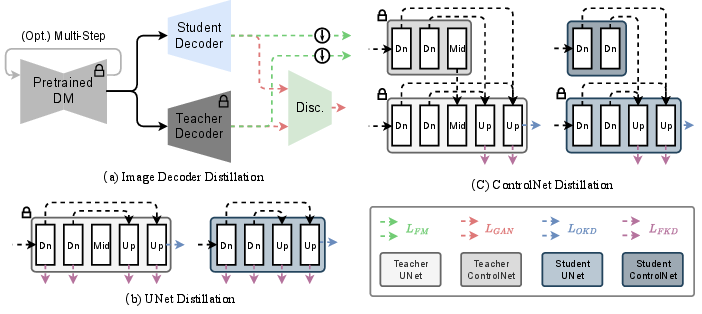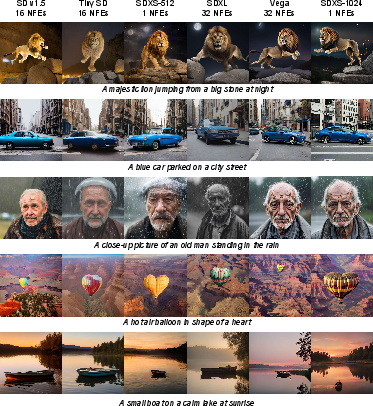SDXS: Real-Time One-Step Latent Diffusion Models with Image Conditions (2403.16627v2)
Abstract: Recent advancements in diffusion models have positioned them at the forefront of image generation. Despite their superior performance, diffusion models are not without drawbacks; they are characterized by complex architectures and substantial computational demands, resulting in significant latency due to their iterative sampling process. To mitigate these limitations, we introduce a dual approach involving model miniaturization and a reduction in sampling steps, aimed at significantly decreasing model latency. Our methodology leverages knowledge distillation to streamline the U-Net and image decoder architectures, and introduces an innovative one-step DM training technique that utilizes feature matching and score distillation. We present two models, SDXS-512 and SDXS-1024, achieving inference speeds of approximately 100 FPS (30x faster than SD v1.5) and 30 FPS (60x faster than SDXL) on a single GPU, respectively. Moreover, our training approach offers promising applications in image-conditioned control, facilitating efficient image-to-image translation.
- High-resolution image synthesis with latent diffusion models. In Proceedings of the IEEE/CVF Conference on Computer Vision and Pattern Recognition, pages 10684–10695, 2022.
- Sdxl: Improving latent diffusion models for high-resolution image synthesis. arXiv preprint arXiv:2307.01952, 2023.
- Hierarchical text-conditional image generation with clip latents. arXiv preprint arXiv:2204.06125, 2022.
- Photorealistic text-to-image diffusion models with deep language understanding. Advances in Neural Information Processing Systems, 35:36479–36494, 2022.
- Adding conditional control to text-to-image diffusion models. In Proceedings of the IEEE/CVF International Conference on Computer Vision, pages 3836–3847, 2023.
- Sdedit: Guided image synthesis and editing with stochastic differential equations. In International Conference on Learning Representations, 2021.
- Repaint: Inpainting using denoising diffusion probabilistic models. In Proceedings of the IEEE/CVF Conference on Computer Vision and Pattern Recognition, pages 11461–11471, 2022.
- Inpaint anything: Segment anything meets image inpainting. arXiv preprint arXiv:2304.06790, 2023.
- Exploiting diffusion prior for real-world image super-resolution. arXiv preprint arXiv:2305.07015, 2023.
- Resshift: Efficient diffusion model for image super-resolution by residual shifting. Advances in Neural Information Processing Systems, 36, 2024.
- Latent video diffusion models for high-fidelity long video generation. arXiv preprint arXiv:2211.13221, 2022.
- Stable video diffusion: Scaling latent video diffusion models to large datasets. arXiv preprint arXiv:2311.15127, 2023.
- Dreamfusion: Text-to-3d using 2d diffusion. In International Conference on Learning Representations, 2022.
- Prolificdreamer: High-fidelity and diverse text-to-3d generation with variational score distillation. Advances in Neural Information Processing Systems, 36, 2024.
- Structural pruning for diffusion models. Advances in Neural Information Processing Systems, 36, 2024.
- Bk-sdm: Architecturally compressed stable diffusion for efficient text-to-image generation. In Workshop on Efficient Systems for Foundation Models@ ICML2023, 2023.
- Progressive knowledge distillation of stable diffusion xl using layer level loss. arXiv preprint arXiv:2401.02677, 2024.
- Post-training quantization on diffusion models. In Proceedings of the IEEE/CVF Conference on Computer Vision and Pattern Recognition, pages 1972–1981, 2023.
- Q-diffusion: Quantizing diffusion models. In Proceedings of the IEEE/CVF International Conference on Computer Vision, pages 17535–17545, 2023.
- Ptqd: Accurate post-training quantization for diffusion models. Advances in Neural Information Processing Systems, 36, 2024.
- Flashattention: Fast and memory-efficient exact attention with io-awareness. Advances in Neural Information Processing Systems, 35:16344–16359, 2022.
- xformers: A modular and hackable transformer modelling library. https://github.com/facebookresearch/xformers, 2022.
- Progressive distillation for fast sampling of diffusion models. In International Conference on Learning Representations, 2021.
- On distillation of guided diffusion models. In Proceedings of the IEEE/CVF Conference on Computer Vision and Pattern Recognition, pages 14297–14306, 2023.
- Snapfusion: Text-to-image diffusion model on mobile devices within two seconds. Advances in Neural Information Processing Systems, 36, 2024.
- Consistency models. arXiv preprint arXiv:2303.01469, 2023.
- Latent consistency models: Synthesizing high-resolution images with few-step inference. arXiv preprint arXiv:2310.04378, 2023.
- Lcm-lora: A universal stable-diffusion acceleration module. arXiv preprint arXiv:2311.05556, 2023.
- Flow straight and fast: Learning to generate and transfer data with rectified flow. In International conference on learning representations (ICLR), 2023.
- Instaflow: One step is enough for high-quality diffusion-based text-to-image generation. In International Conference on Learning Representations, 2024.
- Ufogen: You forward once large scale text-to-image generation via diffusion gans. arXiv preprint arXiv:2311.09257, 2023.
- Adversarial diffusion distillation. arXiv preprint arXiv:2311.17042, 2023.
- Sdxl-lightning: Progressive adversarial diffusion distillation. arXiv preprint arXiv:2402.13929, 2024.
- Lora: Low-rank adaptation of large language models. In International Conference on Learning Representations, 2021.
- Auto-encoding variational bayes. arXiv preprint arXiv:1312.6114, 2013.
- U-net: Convolutional networks for biomedical image segmentation. In MICAI, 2015.
- Diff-instruct: A universal approach for transferring knowledge from pre-trained diffusion models. Advances in Neural Information Processing Systems, 36, 2024.
- Denoising diffusion probabilistic models. Advances in Neural Information Processing Systems, 33:6840–6851, 2020.
- Score-based generative modeling through stochastic differential equations. arXiv preprint arXiv:2011.13456, 2020.
- Stochastic backpropagation and approximate inference in deep generative models. In International Conference on Machine Learning, pages 1278–1286. PMLR, 2014.
- Neural discrete representation learning. Advances in Neural Information Processing Systems, 30, 2017.
- Taming transformers for high-resolution image synthesis. In Proceedings of the IEEE/CVF Conference on Computer Vision and Pattern Recognition, pages 12873–12883, 2021.
- Denoising diffusion implicit models. In International Conference on Learning Representations, 2020.
- Pseudo numerical methods for diffusion models on manifolds. In International Conference on Learning Representations, 2022.
- Dpm-solver: A fast ode solver for diffusion probabilistic model sampling in around 10 steps. Advances in Neural Information Processing Systems, 35:5775–5787, 2022.
- Dpm-solver++: Fast solver for guided sampling of diffusion probabilistic models. arXiv preprint arXiv:2211.01095, 2022.
- Unipc: A unified predictor-corrector framework for fast sampling of diffusion models. Advances in Neural Information Processing Systems, 36, 2024.
- Perceptual losses for real-time style transfer and super-resolution. In European Conference on Computer Vision, pages 694–711. Springer, 2016.
- The unreasonable effectiveness of deep features as a perceptual metric. In Proceedings of the IEEE/CVF Conference on Computer Vision and Pattern Recognition, pages 586–595, 2018.
- Improved techniques for training gans. Advances in Neural Information Processing Systems, 29, 2016.
- Image quality assessment: Unifying structure and texture similarity. IEEE Transactions on Pattern Analysis and Machine Intelligence, 44(5):2567–2581, 2020.
- Very deep convolutional networks for large-scale image recognition. arXiv preprint arXiv:1409.1556, 2014.
- Dinov2: Learning robust visual features without supervision. Transactions on Machine Learning Research, 2023.
- Generative modeling by estimating gradients of the data distribution. Advances in Neural Information Processing Systems, 32, 2019.
- Score distillation sampling with learned manifold corrective. arXiv preprint arXiv:2401.05293, 2024.
- Classifier-free diffusion guidance. arXiv preprint arXiv:2207.12598, 2022.
- Laion-5b: An open large-scale dataset for training next generation image-text models. arXiv preprint arXiv:2210.08402, 2022.
- Stylegan-t: Unlocking the power of gans for fast large-scale text-to-image synthesis. In International Conference on Machine Learning, pages 30105–30118. PMLR, 2023.
- Gans trained by a two time-scale update rule converge to a local nash equilibrium. Advances in Neural Information Processing Systems, 30, 2017.
- Learning transferable visual models from natural language supervision. In International Conference on Machine Learning, pages 8748–8763. PMLR, 2021.
- Microsoft coco: Common objects in context. In European Conference on Computer Vision, pages 740–755. Springer, 2014.
Sponsor
Paper Prompts
Sign up for free to create and run prompts on this paper using GPT-5.
Top Community Prompts
Collections
Sign up for free to add this paper to one or more collections.






